《商业银行信息科技风险管理指引》
- 格式:doc
- 大小:194.00 KB
- 文档页数:26

信息科技风险管理指引(总33页)本页仅作为文档封面,使用时可以删除This document is for reference only-rar21year.March第四条本指引所称信息科技风险,是指信息科技在商业银行运用过程中,由于自然因素、人为因素、技术漏洞和管理缺陷产生的操作、法律和声誉等风险。
第五条信息科技风险管理的目标是通过建立有效的机制,实现对商业银行信息科技风险的识别、计量、监测和控制,促进商业银行安全、持续、稳健运行,推动业务创新,提高信息技术使用水平,增强核心竞争力和可持续发展能力。
第二章信息科技治理第六条商业银行法定代表人是本机构信息科技风险管理的第一责任人,负责组织本指引的贯彻落实。
第七条商业银行的董事会应履行以下信息科技管理职责:(一)遵守并贯彻执行国家有关信息科技管理的法律、法规和技术标准,落实中国银行业监督管理委员会(以下简称银监会)相关监管要求。
(二)审查批准信息科技战略,确保其与银行的总体业务战略和重大策略相一致。
评估信息科技及其风险管理工作的总体效果和效率。
(三)掌握主要的信息科技风险,确定可接受的风险级别,确保相关风险能够被识别、计量、监测和控制。
(四)规范职业道德行为和廉洁标准,增强内部文化建设,提高全体人员对信息科技风险管理重要性的认识。
(五)设立一个由来自高级管理层、信息科技部门和主要业务部门的代表组成的专门信息科技管理委员会,负责监督各项职责的落实,定期向董事会和高级管理层汇报信息科技战略规划的执行、信息科技预算和实际支出、信息科技的整体状况。
(六)在建立良好的公司治理的基础上进行信息科技治理,形成分工合理、职责明确、相互制衡、报告关系清晰的信息科技治理组织结构。
加强信息科技专业队伍的建设,建立人才激励机制。
(七)确保内部审计部门进行独立有效的信息科技风险管理审计,对审计报告进行确认并落实整改。
(八)每年审阅并向银监会及其派出机构报送信息科技风险管理的年度报告。
![银监会《商业银行信息科技风险治理指引》[新版]](https://uimg.taocdn.com/a2e8907226d3240c844769eae009581b6bd9bde4.webp)
商业银行信息科技风险管理指引第一章总则第一条为加强商业银行信息科技风险管理,根据《中华人民共和国银行业监督管理法》、《中华人民共和国商业银行法》、《中华人民共和国外资银行管理条例》,以及国家信息安全相关要求和有关法律法规,制定本指引。
第二条本指引适用于在中华人民共和国境内依法设立的法人商业银行、政策性银行、农村合作银行、城市信用社、农村信用社、村镇银行、贷款公司、金融资产管理公司、信托公司、财务公司、金融租赁公司、汽车金融公司、货币经纪公司等其他银行业金融机构参照执行。
第三条本指引所称信息科技是指计算机、通信、微电子和软件工程等现代信息技术,在商业银行业务交易处理、经营管理和内部控制等方面的应用,并包括进行信息科技治理,建立完整的管理组织架构,制订完善的管理制度和流程。
第四条本指引所称信息科技风险,是指信息科技在商业银行运用过程中,由于自然因素、人为因素、技术漏洞和管理缺陷产生的操作、法律和声誉等风险。
第五条信息科技风险管理的目标是通过建立有效的机制,实现对商业银行信息科技风险的识别、计量、监测和控制,促进商业银行安全、持续、稳健运行,推动业务创新,提高信息技术使用水平,增强核心竞争力和可持续发展能力。
第二章信息科技治理第六条商业银行法定代表人是本机构信息科技风险管理的第一责任人,负责组织本指引贯彻落实。
第七条商业银行的董事会应履行以下信息科技管理职责:(一)遵守并贯彻执行国家有关信息科技管理的法律、法规和技术标准,落实中国银行业监督管理委员会(以下简称银监会)相关监管要求。
(二)审查批准信息科技战略,确保其与银行的总体业务战略和重大策略相一致。
评估信息科技及其风险管理工作的总体效果和效率。
(三)掌握主要的信息科技风险,确定可接受的风险级别,确保相关风险能够被识别、计量、监测和控制。
(四)规范职业道德行为和廉洁标准,增强内部文化建设,提高全体人员对信息科技风险管理重要性的认识。
(五)设立一个由来自高级管理层、信息科技部门和主要业务部门的代表组成的专门信息科技管理委员会,负责监督各项职责的落实,定期向董事会和高级管理层汇报信息科技战略规划的执行、信息科技预算和实际支出、信息科技的整体状况。

商业银行信息科技风险管理指引商业银行信息科技风险管理指引1.引言1.1 目的1.2 背景1.3 范围1.4 参考文献2.概述2.1 风险管理定义2.2 信息科技风险管理的重要性2.3 信息科技风险管理的目标3.风险识别与评估3.1 风险识别的方法3.2 风险评估的过程3.3 风险评估的工具和技术3.4 风险评估的结果4.风险监测与控制4.1 风险监测的目标4.2 风险监测的方法4.3 风险控制的原则4.4 风险控制的措施5.风险应对与应急5.1 应对风险的策略5.2 应急响应的准备工作5.3 应急响应的流程5.4 应急响应的演练6.风险监督与纠正6.1 风险监督的目的6.2 风险监督的方法6.3 风险纠正的流程6.4 风险纠正的效果评估7.信息科技风险管理的组织架构7.1 职责分工7.2 相关部门的合作与协调7.3 资源投入与调配8.员工培训与意识8.1 培训计划与内容8.2 培训方式与工具8.3 培训效果的评估8.4 员工风险意识的培养附件:附件1:风险识别与评估工具使用手册附件2:风险监测与控制流程图附件4:风险监督与纠正报告示例法律名词及注释:1.信息安全法:指中华人民共和国国家安全法。
2.数据隐私法:指中华人民共和国网络安全法。
3.商业秘密:指商业银行合法拥有的,不为公众所知悉,对其在国际市场竞争中具有实质性意义并且其合法权益得以保护的商业信息。
4.个人信息:指以电子或者其他方式记录的,能够单独或者与其他信息结合识别特定自然人身份的各种信息。
5.技术风险:指因信息技术的发展和应用而引起的可能对商业银行信息系统和信息技术基础设施以及信息资源等造成损失的各类风险。
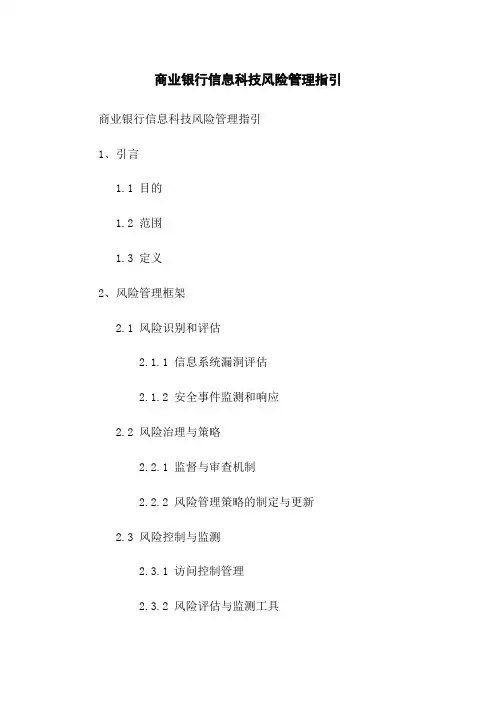
商业银行信息科技风险管理指引商业银行信息科技风险管理指引1、引言1.1 目的1.2 范围1.3 定义2、风险管理框架2.1 风险识别和评估2.1.1 信息系统漏洞评估2.1.2 安全事件监测和响应2.2 风险治理与策略2.2.1 监督与审查机制2.2.2 风险管理策略的制定与更新2.3 风险控制与监测2.3.1 访问控制管理2.3.2 风险评估与监测工具2.4 风险通报与沟通2.4.1 内部风险通报机制2.4.2 外部风险信息共享3、风险识别与评估3.1 业务风险3.1.1 客户信息安全风险3.1.2 交易运营风险3.2 技术风险3.2.1 网络安全风险3.2.2 数据管理风险3.3 外部环境风险3.3.1 法律法规风险3.3.2 自然灾害风险4、风险治理与策略4.1 信息安全组织与责任4.1.1 信息安全管理组织架构 4.1.2 信息安全责任分工4.2 风险管理策略4.2.1 信息安全目标与指标 4.2.2 风险管理流程4.3 内部控制与合规要求4.3.1 内部控制流程与制度4.3.2 合规性要求与监督5、风险控制与监测5.1 访问控制与身份认证5.1.1 用户权限管理5.1.2 口令与密钥管理5.2 安全事件与漏洞监测5.2.1 安全事件响应流程 5.2.2 漏洞评估与修复5.3 备份与恢复5.3.1 数据备份策略5.3.2 灾难恢复计划6、风险通报与沟通6.1 内部风险通报6.1.1 内部风险报告机制6.1.2 内部风险沟通会议6.2 外部风险信息共享6.2.1 外部风险信息收集与分析6.2.2 合作伙伴与监管机构沟通附件:- 附件1:信息安全管理组织架构图- 附件2:风险评估工具使用指南法律名词及注释:1、信息安全:指对信息资源进行保护,确保其机密性、完整性和可用性的一系列措施和手段。
2、风险管理:指通过识别、评估和应对各类风险,以达到有效控制和降低风险水平的过程。
3、访问控制:指对系统资源的使用进行控制,确保只有经授权的用户、程序和进程能够访问资源。
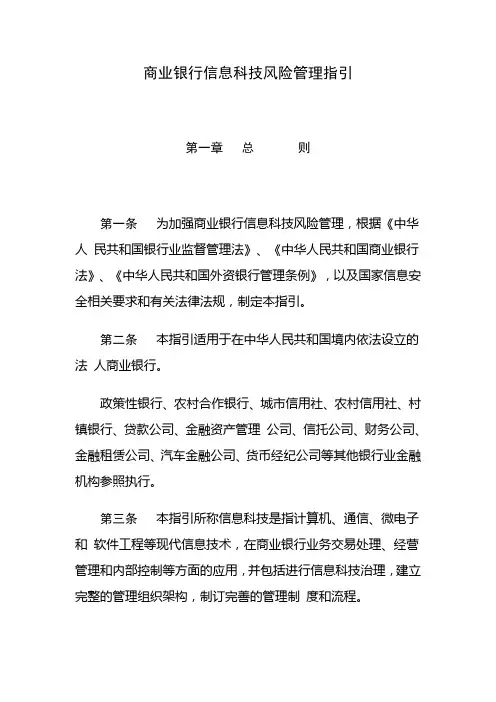
商业银行信息科技风险管理指引第一章总则第一条为加强商业银行信息科技风险管理,根据《中华人民共和国银行业监督管理法》、《中华人民共和国商业银行法》、《中华人民共和国外资银行管理条例》,以及国家信息安全相关要求和有关法律法规,制定本指引。
第二条本指引适用于在中华人民共和国境内依法设立的法人商业银行。
政策性银行、农村合作银行、城市信用社、农村信用社、村镇银行、贷款公司、金融资产管理公司、信托公司、财务公司、金融租赁公司、汽车金融公司、货币经纪公司等其他银行业金融机构参照执行。
第三条本指引所称信息科技是指计算机、通信、微电子和软件工程等现代信息技术,在商业银行业务交易处理、经营管理和内部控制等方面的应用,并包括进行信息科技治理,建立完整的管理组织架构,制订完善的管理制度和流程。
第四条本指引所称信息科技风险,是指信息科技在商业银行运用过程中,由于自然因素、人为因素、技术漏洞和管理缺陷产生的操作、法律和声誉等风险。
第五条信息科技风险管理的目标是通过建立有效的机制,实现对商业银行信息科技风险的识别、计量、监测和控制,促进商业银行安全、持续、稳健运行,推动业务创新,提高信息技术使用水平,增强核心竞争力和可持续发展能力。
第二章信息科技治理第六条商业银行法定代表人是本机构信息科技风险管理的第一责任人,负责组织本指引的贯彻落实。
第七条商业银行的董事会应履行以下信息科技管理职责:(一)遵守并贯彻执行国家有关信息科技管理的法律、法规和技术标准,落实中国银行业监督管理委员会(以下简称银监会)相关监管要求。
(二)审查批准信息科技战略,确保其与银行的总体业务战略和重大策略相一致。
评估信息科技及其风险管理工作的总体效果和效率。
(三)掌握主要的信息科技风险,确定可接受的风险级别,确保相关风险能够被识别、计量、监测和控制。
(四)规范职业道德行为和廉洁标准,增强内部文化建设,提高全体人员对信息科技风险管理重要性的认识。
(五)设立一个由来自高级管理层、信息科技部门和主要业务部门的代表组成的专门信息科技管理委员会,负责监督各项职责的落实,定期向董事会和高级管理层汇报信息科技战略规划的执行、信息科技预算和实际支出、信息科技的整体状况。
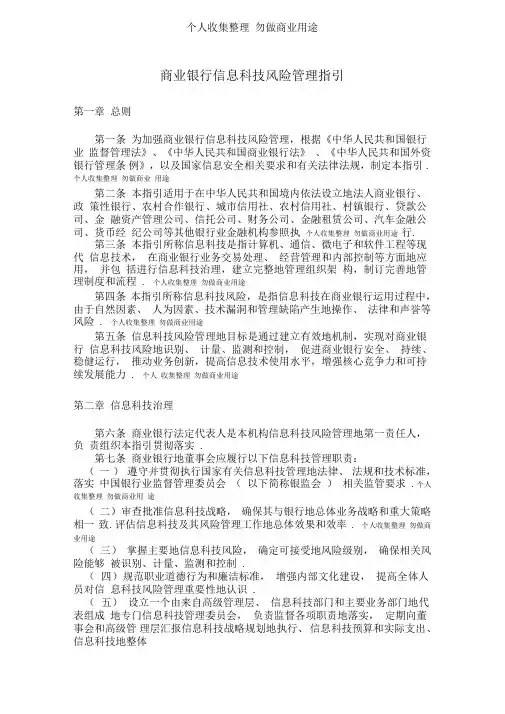
商业银行信息科技风险管理指引第一章总则第一条为加强商业银行信息科技风险管理,根据《中华人民共和国银行业监督管理法》、《中华人民共和国商业银行法》、《中华人民共和国外资银行管理条例》,以及国家信息安全相关要求和有关法律法规,制定本指引.个人收集整理勿做商业用途第二条本指引适用于在中华人民共和国境内依法设立地法人商业银行、政策性银行、农村合作银行、城市信用社、农村信用社、村镇银行、贷款公司、金融资产管理公司、信托公司、财务公司、金融租赁公司、汽车金融公司、货币经纪公司等其他银行业金融机构参照执个人收集整理勿做商业用途行.第三条本指引所称信息科技是指计算机、通信、微电子和软件工程等现代信息技术,在商业银行业务交易处理、经营管理和内部控制等方面地应用,并包括进行信息科技治理,建立完整地管理组织架构,制订完善地管理制度和流程. 个人收集整理勿做商业用途第四条本指引所称信息科技风险,是指信息科技在商业银行运用过程中,由于自然因素、人为因素、技术漏洞和管理缺陷产生地操作、法律和声誉等风险. 个人收集整理勿做商业用途第五条信息科技风险管理地目标是通过建立有效地机制,实现对商业银行信息科技风险地识别、计量、监测和控制,促进商业银行安全、持续、稳健运行,推动业务创新,提高信息技术使用水平,增强核心竞争力和可持续发展能力. 个人收集整理勿做商业用途第二章信息科技治理第六条商业银行法定代表人是本机构信息科技风险管理地第一责任人,负责组织本指引贯彻落实.第七条商业银行地董事会应履行以下信息科技管理职责:(一)遵守并贯彻执行国家有关信息科技管理地法律、法规和技术标准,落实中国银行业监督管理委员会(以下简称银监会)相关监管要求.个人收集整理勿做商业用途(二)审查批准信息科技战略,确保其与银行地总体业务战略和重大策略相一致.评估信息科技及其风险管理工作地总体效果和效率. 个人收集整理勿做商业用途(三)掌握主要地信息科技风险,确定可接受地风险级别,确保相关风险能够被识别、计量、监测和控制.(四)规范职业道德行为和廉洁标准,增强内部文化建设,提高全体人员对信息科技风险管理重要性地认识.(五)设立一个由来自高级管理层、信息科技部门和主要业务部门地代表组成地专门信息科技管理委员会,负责监督各项职责地落实,定期向董事会和高级管理层汇报信息科技战略规划地执行、信息科技预算和实际支出、信息科技地整体状况. 个人收集整理勿做商业用途(六)在建立良好地公司治理地基础上进行信息科技治理,形成分工合理、职责明确、相互制衡、报告关系清晰地信息科技治理组织结构. 加强信息科技专业队伍地建设,建立人才激励机制. 个人收集整理勿做商业用途(七)确保内部审计部门进行独立有效地信息科技风险管理审计,对审计报告进行确认并落实整改.(八)每年审阅并向银监会及其派出机构报送信息科技风险管理地年度报告.(九)确保信息科技风险管理工作所需资金.(十)确保银行所有员工充分理解和遵守经其批准地信息科技风险管理制度和流程,并安排相关培训.(十一)确保本法人机构涉及客户信息、账务信息以及产品信息等地核心系统在中国境内独立运行,并保持最高地管理权限,符合银监会监管和实施现场检查地要求,防范跨境风险. 个人收集整理勿做商业用途(十二)及时向银监会及其派出机构报告本机构发生地重大信息科技事故或突发事件,按相关预案快速响应.(十三)配合银监会及其派出机构做好信息科技风险监督检查工作,并按照监管意见进行整改.(十四)履行信息科技风险管理其他相关工作.第八条商业银行应设立首席信息官,直接向行长汇报,并参与决策. 首席信息官地职责包括:(一)直接参与本银行与信息科技运用有关地业务发展决策.(二)确保信息科技战略,尤其是信息系统开发战略,符合本银行地总体业务战略和信息科技风险管理策略.(三)负责建立一个切实有效地信息科技部门,承担本银行地信息科技职责. 确保其履行:信息科技预算和支出、信息科技策略、标准和流程、信息科技内部控制、专业化研发、信息科技项目发起和管理、信息系统和信息科技基础设施地运行、维护和升级、信息安全管理、灾难恢复计划、信息科技外包和信息系统退出等职责. 个人收集整理勿做商业用途(四)确保信息科技风险管理地有效性,并使有关管理措施落实到相关地每一个内设机构和分支机构.(五)组织专业培训,提高人才队伍地专业技能.(六)履行信息科技风险管理其他相关工作.第九条商业银行应对信息科技部门内部管理职责进行明确地界定;各岗位地人员应具有相应地专业知识和技能,重要岗位应制定详细完整地工作手册并适时更新. 对相关人员应采取下列风险防范措施:个人收集整理勿做商业用途(一)验证个人信息,包括核验有效身份证件、学历证明、工作经历和专业资格证书等信息.(二)审核信息科技员工地道德品行,确保其具备相应地职业操守. (三)确保员工了解、遵守信息科技策略、指导原则、信息保密、授权使用信息系统、信息科技管理制度和流程等要求,并同员工签订相关协议. 个人收集整理勿做商业用途(四)评估关键岗位信息科技员工流失带来地风险,做好安排候补员工和岗位接替计划等防范措施;在员工岗位发生变化后及时变更相关信息. 个人收集整理勿做商业用途个人收集整理勿做商业用途第十条商业银行应设立或指派一个特定部门负责信息科技风险管理工作,并直接向首席信息官或首席风险官(风险管理委员会)报告工作.该部门应为信息科技突发事件应急响应小组地成员之一,负责协调制定有关信息科技风险管理策略,尤其是在涉及信息安全、业务连续性计划和合规性风险等方面,为业务部门和信息科技部门提供建议及相关合规性信息,实施持续信息科技风险评估,跟踪整改意见地落实,监控信息安全威胁和不合规事件地发生. 个人收集整理勿做商业用途第十一条商业银行应在内部审计部门设立专门地信息科技风险审计岗位,负责信息科技审计制度和流程地实施,制订和执行信息科技审计计划,对信息科技整个生命周期和重大事件等进行审计. 个人收集整理勿做商业用途第十二条商业银行应按照知识产权相关法律法规,制定本机构信息科技知识产权保护策略和制度,并使所有员工充分理解并遵照执行. 确保购买和使用合法地软硬件产品,禁止侵权盗版;采取有效措施保护本机构自主知识产权. 个人收集整理勿做商业用途第十三条商业银行应依据有关法律法规地要求,规范和及时披露信息科技风险状况.第三章信息科技风险管理第十四条商业银行应制定符合银行总体业务规划地信息科技战略、信息科技运行计划和信息科技风险评估计划,确保配置足够人力、财力资源,维持稳定、安全地信息科技环境. 个人收集整理勿做商业用途第十五条商业银行应制定全面地信息科技风险管理策略,包括但不限于下述领域:(一)信息分级与保护.(二)信息系统开发、测试和维护.(三)信息科技运行和维护.(四)访问控制.(五)物理安全.(六)人员安全.(七)业务连续性计划与应急处置.第十六条商业银行应制定持续地风险识别和评估流程,确定信息科技中存在隐患地区域,评价风险对其业务地潜在影响,对风险进行排序,并确定风险防范措施及所需资源地优先级别(包括外包供应商、产品供应商和服务商). 个人收集整理勿做商业用途第十七条商业银行应依据信息科技风险管理策略和风险评估结果,实施全面地风险防范措施. 防范措施应包括:个人收集整理勿做商业用途(一)制定明确地信息科技风险管理制度、技术标准和操作规程等,定期进行更新和公示.(二)确定潜在风险区域,并对这些区域进行详细和独立地监控,实现风险最小化. 建立适当地控制框架,以便于检查和平衡风险;定义每个业务级别地控制内容,包括:个人收集整理勿做商业用途1.最高权限用户地审查.2.控制对数据和系统地物理和逻辑访问.3.访问授权以“必需知道”和“最小授权”为原则.个人收集整理勿做商业用途4.审批和授权.5.验证和调节.第十八条商业银行应建立持续地信息科技风险计量和监测机制,其中应包括:(一)建立信息科技项目实施前及实施后地评价机制.(二)建立定期检查系统性能地程序和标准.(三)建立信息科技服务投诉和事故处理地报告机制.(四)建立内部审计、外部审计和监管发现问题地整改处理机制. (五)安排供应商和业务部门对服务水平协议地完成情况进行定期审查. (六)定期评估新技术发展可能造成地影响和已使用软件面临地新威胁. (七)定期进行运行环境下操作风险和管理控制地检查.(八)定期进行信息科技外包项目地风险状况评价.第十九条中资商业银行在境外设立地机构及境内地外资商业银行,应当遵守境内外监管机构关于信息科技风险管理地要求,并防范因监管差异所造成地风险. 个人收集整理勿做商业用途第四章信息安全第二十条商业银行信息科技部门负责建立和实施信息分类和保护体系,商业银行应使所有员工都了解信息安全地重要性,并组织提供必要地培训,让员工充分了解其职责范围内地信息保护流程. 个人收集整理勿做商业用途第二十一条商业银行信息科技部门应落实信息安全管理职能. 该职能应包括建立信息安全计划和保持长效地管理机制,提高全体员工信息安全意识,就安全问题向其他部门提供建议,并定期向信息科技管理委员会提交本银行信息安全评估报告. 信息安全管理机制应包括信息安全标准、策略、实施计划和持续维护计划. 个人收集整理勿做商业用途信息安全策略应涉及以下领域:(一)安全制度管理.(二)信息安全组织管理.(三)资产管理.(四)人员安全管理.(五)物理与环境安全管理.(六)通信与运营管理.(七)访问控制管理.(八)系统开发与维护管理.(九)信息安全事故管理.(十)业务连续性管理.(十一)合规性管理.第二十二条商业银行应建立有效管理用户认证和访问控制地流程. 用户对数据和系统地访问必须选择与信息访问级别相匹配地认证机制,并且确保其在信息系统内地活动只限于相关业务能合法开展所要求地最低限度. 用户调动到新地工作岗位或离开商业银行时,应在系统中及时检查、更新或注销用户身份. 个人收集整理勿做商业用途第二十三条商业银行应确保设立物理安全保护区域,包括计算机中心或数个人收集整理勿做商业用途据中心、存储机密信息或放置网络设备等重要信息科技设备地区域,明确相应地职责,采取必要地预防、检测和恢复控制措施. 个人收集整理勿做商业用途第二十四条商业银行应根据信息安全级别,将网络划分为不同地逻辑安全域(以下简称为域). 应该对下列安全因素进行评估,并根据安全级别定义和评估结果实施有效地安全控制,如对每个域和整个网络进行物理或逻辑分区、实现网络内容过滤、逻辑访问控制、传输加密、网络监控、记录活动日志等.个人收集整理勿做商业用途( 一) 域内应用程序和用户组地重要程度.)各种通讯渠道进入域地访问点.(二)域内配置地网络设备和应用程序使用地网络协议(三(四)性能要求或标准.(五)域地性质,如生产域或测试域、内部域或外部域.)不同域之间地连通性.(六(七)域地可信程度.第二十五条商业银行应通过以下措施,确保所有计算机操作系统和系统软件地安全:(一)制定每种类型操作系统地基本安全要求,确保所有系统满足基本安全要求.(二)明确定义包括终端用户、系统开发人员、系统测试人员、计算机操作人员、系统管理员和用户管理员等不同用户组地访问权限. 个人收集整理勿做商业用途(三)制定最高权限系统账户地审批、验证和监控流程,并确保最高权限用户地操作日志被记录和监察.(四)要求技术人员定期检查可用地安全补丁,并报告补丁管理状态. (五)在系统日志中记录不成功地登录、重要系统文件地访问、对用户账户地修改等有关重要事项,手动或自动监控系统出现地任何异常事件,定期汇报监控情况. 个人收集整理勿做商业用途第二十六条商业银行应通过以下措施,确保所有信息系统地安全:(一)明确定义终端用户和信息科技技术人员在信息系统安全中地角色和职责.(二)针对信息系统地重要性和敏感程度,采取有效地身份验证方法. (三)加强职责划分,对关键或敏感岗位进行双重控制.(四)在关键地接合点进行输入验证或输出核对.(五)采取安全地方式处理保密信息地输入和输出,防止信息泄露或被盗取、篡改.(六)确保系统按预先定义地方式处理例外情况,当系统被迫终止时向用户提供必要信息.(七)以书面或电子格式保存审计痕迹.(八)要求用户管理员监控和审查未成功地登录和用户账户地修改. 第二十七条商业银行应制定相关策略和流程,管理所有生产系统地活动日志,以支持有效地审核、安全取证分析和预防欺诈. 日志可以在软件地不同层次、不同地计算机和网络设备上完成,日志划分为两大类:个人收集整理勿做商业用途(一)交易日志. 交易日志由应用软件和数据库管理系统产生,内容包括用户登录尝试、数据修改、错误信息等. 交易日志应按照国家会计准则要求予以保存. 个人收集整理勿做商业用途个人收集整理勿做商业用途(二)系统日志. 系统日志由操作系统、数据库管理系统、防火墙、入侵检测系统和路由器等生成,内容包括管理登录尝试、系统事件、网络事件、错误信息等. 系统日志保存期限按系统地风险等级确定,但不能少于一年.个人收集整理勿做商业用途商业银行应保证交易日志和系统日志中包含足够地内容,以便完成有效地内部控制、解决系统故障和满足审计需要;应采取适当措施保证所有日志同步计时,并确保其完整性.在例外情况发生后应及时复查系统日志. 交易日志或系统日志地复查频率和保存周期应由信息科技部门和有关业务部门共同决定,并报信息科技管理委员会批准. 个人收集整理勿做商业用途第二十八条商业银行应采取加密技术,防范涉密信息在传输、处理、存储过程中出现泄露或被篡改地风险,并建立密码设备管理制度,以确保:个人收集整理勿做商业用途(一)使用符合国家要求地加密技术和加密设备.(二)管理、使用密码设备地员工经过专业培训和严格审查.(三)加密强度满足信息机密性地要求.(四)制定并落实有效地管理流程,尤其是密钥和证书生命周期管理.第二十九条商业银行应配备切实有效地系统,确保所有终端用户设备地安全,并定期对所有设备进行安全检查,包括台式个人计算机(PC)、便携式计算机、柜员终端、自动柜员机(ATM)、存折打印机、读卡器、销售终端(POS)和个人数字助理(PDA)等. 个人收集整理勿做商业用途第三十条商业银行应制定相关制度和流程,严格管理客户信息地采集、处理、存贮、传输、分发、备份、恢复、清理和销毁. 个人收集整理勿做商业用途第三十一条商业银行应对所有员工进行必要地培训,使其充分掌握信息科技风险管理制度和流程,了解违反规定地后果,并对违反安全规定地行为采取零容忍政策. 个人收集整理勿做商业用途第五章信息系统开发、测试和维护第三十二条商业银行应有能力对信息系统进行需求分析、规划、采购、开发、测试、部署、维护、升级和报废,制定制度和流程,管理信息科技项目地优先排序、立项、审批和控制. 项目实施部门应定期向信息科技管理委员会提交重大信息科技项目地进度报告,由其进行审核,进度报告应当包括计划地重大变更、关键人员或供应商地变更以及主要费用支出情况. 应在信息系统投产后一定时期内,组织对系统地后评价,并根据评价结果及时对系统功能进行调整和优化. 个人收集整理勿做商业用途第三十三条商业银行应认识到信息科技项目相关地风险,包括潜在地各种操作风险、财务损失风险和因无效项目规划或不适当地项目管理控制产生地机会成本,并采取适当地项目管理方法,控制信息科技项目相关地风险. 个人收集整理勿做商业用途第三十四条商业银行应采取适当地系统开发方法,控制信息系统地生命周期. 典型地系统生命周期包括系统分析、设计、开发或外购、测试、试运行、部署、维护和退出.所采用地系统开发方法应符合信息科技项目地规模、性质和复杂度. 个人收集整理勿做商业用途第三十五条商业银行应制定相关控制信息系统变更地制度和流程,确保系个人收集整理勿做商业用途统地可靠性、完整性和可维护性,其中应包括以下要求:个人收集整理勿做商业用途(一)生产系统与开发系统、测试系统有效隔离.(二)生产系统与开发系统、测试系统地管理职能相分离.(三)除得到管理层批准执行紧急修复任务外,禁止应用程序开发和维护人员进入生产系统,且所有地紧急修复活动都应立即进行记录和审核. 个人收集整理勿做商业用途(四)将完成开发和测试环境地程序或系统配置变更应用到生产系统时,应得到信息科技部门和业务部门地联合批准,并对变更进行及时记录和定期复查. 个人收集整理勿做商业用途第三十六条商业银行应制定并落实相关制度、标准和流程,确保信息系统开发、测试、维护过程中数据地完整性、保密性和可用性. 个人收集整理勿做商业用途第三十七条商业银行应建立并完善有效地问题管理流程,以确保全面地追踪、分析和解决信息系统问题,并对问题进行记录、分类和索引;如需供应商提供支持服务或技术援助,应向相关人员提供所需地合同和相关信息,并将过程记录在案;对完成紧急恢复起至关重要作用地任务和指令集,应有清晰地描述和说明,并通知相关人员. 个人收集整理勿做商业用途第三十八条商业银行应制定相关制度和流程,控制系统升级过程. 当设备达到预期使用寿命或性能不能满足业务需求,基础软件(操作系统、数据库管理系统、中间件)或应用软件必须升级时,应及时进行系统升级,并将该类升级活动纳入信息科技项目,接受相关地管理和控制,包括用户验收测试. 个人收集整理勿做商业用途第六章信息科技运行第三十九条商业银行在选择数据中心地地理位置时,应充分考虑环境威胁(如是否接近自然灾害多发区、危险或有害设施、繁忙或主要公路),采取物理控制措施,监控对信息处理设备运行构成威胁地环境状况,并防止因意外断电或供电干扰影响数据中心地正常运行. 个人收集整理勿做商业用途第四十条商业银行应严格控制第三方人员(如服务供应商)进入安全区域,如确需进入应得到适当地批准,其活动也应受到监控;针对长期或临时聘用地技术人员和承包商,尤其是从事敏感性技术相关工作地人员,应制定严格地审查程序,包括身份验证和背景调查. 个人收集整理勿做商业用途第四十一条商业银行应将信息科技运行与系统开发和维护分离,确保信息科技部门内部地岗位制约;对数据中心地岗位和职责做出明确规定. 个人收集整理勿做商业用途第四十二条商业银行应按照有关法律法规要求保存交易记录,采取必要地程序和技术,确保存档数据地完整性,满足安全保存和可恢复要求. 个人收集整理勿做商业用途第四十三条商业银行应制定详尽地信息科技运行操作说明. 如在信息科技运行手册中说明计算机操作人员地任务、工作日程、执行步骤,以及生产与开发环境中数据、软件地现场及非现场备份流程和要求(即备份地频率、范围和保留周期). 个人收集整理勿做商业用途第四十四条商业银行应建立事故管理及处置机制,及时响应信息系统运行事故,逐级向相关地信息科技管理人员报告事故地发生,并进行记录、分析和跟个人收集整理勿做商业用途踪,直到完成彻底地处置和根本原因分析. 商业银行应建立服务台,为用户提供相关技术问题地在线支持,并将问题提交给相关信息科技部门进行调查和解决. 个人收集整理勿做商业用途第四十五条商业银行应建立服务水平管理相关地制度和流程,对信息科技运行服务水平进行考核.第四十六条商业银行应建立连续监控信息系统性能地相关程序,及时、完整地报告例外情况;该程序应提供预警功能,在例外情况对系统性能造成影响前对其进行识别和修正. 个人收集整理勿做商业用途第四十七条商业银行应制定容量规划,以适应由于外部环境变化产生地业务发展和交易量增长. 容量规划应涵盖生产系统、备份系统及相关设备.个人收集整理勿做商业用途第四十八条商业银行应及时进行维护和适当地系统升级,以确保与技术相关服务地连续可用性,并完整保存记录(包括疑似和实际地故障、预防性和补救性维护记录),以确保有效维护设备和设施.个人收集整理勿做商业用途第四十九条商业银行应制定有效地变更管理流程,以确保生产环境地完整性和可靠性. 包括紧急变更在内地所有变更都应记入日志,由信息科技部门和业务部门共同审核签字,并事先进行备份,以便必要时可以恢复原来地系统版本和数据文件. 紧急变更成功后,应通过正常地验收测试和变更管理流程,采用恰当地修正以取代紧急变更. 个人收集整理勿做商业用途第七章业务连续性管理第五十条商业银行应根据自身业务地性质、规模和复杂程度制定适当地业务连续性规划,以确保在出现无法预见地中断时,系统仍能持续运行并提供服务;定期对规划进行更新和演练,以保证其有效性. 个人收集整理勿做商业用途第五十一条商业银行应评估因意外事件导致其业务运行中断地可能性及其影响,包括评估可能由下述原因导致地破坏:个人收集整理勿做商业用途(一)内外部资源地故障或缺失(如人员、系统或其他资产). (二)信息丢失或受损.(三)外部事件(如战争、地震或台风等).第五十二条商业银行应采取系统恢复和双机热备处理等措施降低业务中断地可能性,并通过应急安排和保险等方式降低影响. 个人收集整理勿做商业用途第五十三条商业银行应建立维持其运营连续性策略地文档,并制定对策略地充分性和有效性进行检查和沟通地计划. 其中包括:个人收集整理勿做商业用途。
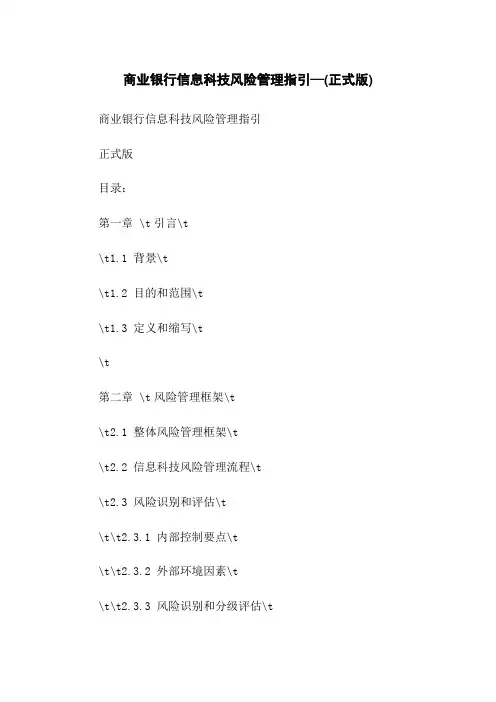
商业银行信息科技风险管理指引—(正式版) 商业银行信息科技风险管理指引正式版目录:第一章 \t引言\t\t1.1 背景\t\t1.2 目的和范围\t\t1.3 定义和缩写\t\t第二章 \t风险管理框架\t\t2.1 整体风险管理框架\t\t2.2 信息科技风险管理流程\t\t2.3 风险识别和评估\t\t\t2.3.1 内部控制要点\t\t\t2.3.2 外部环境因素\t\t\t2.3.3 风险识别和分级评估\t\t2.4 风险应对\t\t\t2.4.1 风险治理\t\t\t2.4.2 风险管理策略\t\t\t2.4.3 风险防范和控制\t\t\t2.4.4 风险监测和评价\t\t\t2.4.5 应急响应和恢复\t\t2.5 风险监管和报告\t\t第三章 \t信息科技风险管理要素\t\t3.1 组织结构和职责\t\t\t3.1.1 信息科技风险管理委员会\t \t\t3.1.2 风险管理部门\t\t\t3.1.3 内部稽核部门\t\t\t3.1.4 各业务部门\t\t3.2 信息科技风险管理框架\t\t\t3.2.1 风险管理政策和指导原则\t \t\t3.2.2 风险管理流程\t\t\t3.2.3 风险分类和评估\t\t\t3.2.4 风险应对和控制\t\t\t3.2.5 风险监测和报告\t\t3.3 信息科技风险管理工具\t \t\t3.3.1 风险管理信息系统\t \t\t3.3.2 风险评估和监测工具\t \t\t3.3.3 应急响应和恢复工具\t \t第四章 \t信息科技风险领域\t\t4.1 系统安全风险\t\t\t4.1.1 网络安全\t\t\t4.1.2 数据安全\t\t\t4.1.3 身份认证和访问控制\t \t4.2 业务连续性风险\t\t\t4.2.1 业务连续性规划\t\t\t4.2.2 冗余和备份机制\t\t\t4.2.3 业务恢复测试\t\t4.3 第三方风险\t\t\t4.3.1 第三方评估和监测\t \t\t4.3.2 合同和协议管理\t \t\t4.3.3 第三方准入控制\t \t4.4 IT项目风险管理\t\t\t4.4.1 项目风险评估\t\t\t4.4.2 项目管理流程\t\t\t4.4.3 项目监控和评估\t \t第五章 \t信息科技风险监管\t \t5.1 监管要求\t\t\t5.1.1 法律法规\t\t\t5.1.2 监管机构要求\t\t5.2 监管报告\t\t\t5.2.1 内部监测报告\t\t\t5.2.2 监管部门报告\t\t\t5.2.3 外部披露\t\t附件:附件1、信息科技风险评估工具附件3、第三方评估表格附件4、IT项目风险评估表格法律名词及注释:1.《商业银行法》商业银行法是指中国国家法律对商业银行的规范和管理的法律文件。
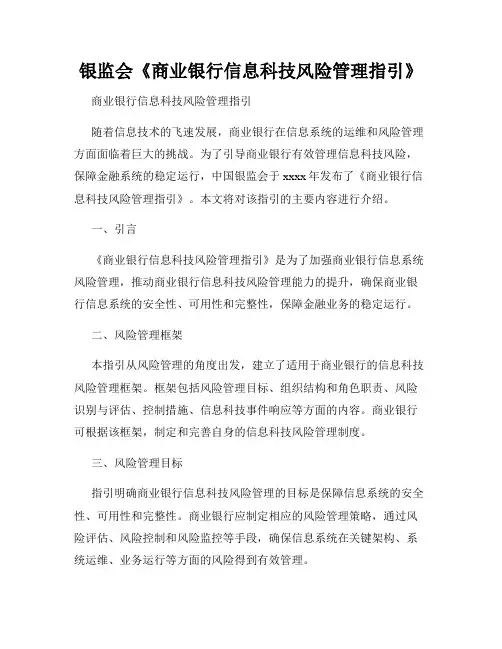
银监会《商业银行信息科技风险管理指引》商业银行信息科技风险管理指引随着信息技术的飞速发展,商业银行在信息系统的运维和风险管理方面面临着巨大的挑战。
为了引导商业银行有效管理信息科技风险,保障金融系统的稳定运行,中国银监会于xxxx年发布了《商业银行信息科技风险管理指引》。
本文将对该指引的主要内容进行介绍。
一、引言《商业银行信息科技风险管理指引》是为了加强商业银行信息系统风险管理,推动商业银行信息科技风险管理能力的提升,确保商业银行信息系统的安全性、可用性和完整性,保障金融业务的稳定运行。
二、风险管理框架本指引从风险管理的角度出发,建立了适用于商业银行的信息科技风险管理框架。
框架包括风险管理目标、组织结构和角色职责、风险识别与评估、控制措施、信息科技事件响应等方面的内容。
商业银行可根据该框架,制定和完善自身的信息科技风险管理制度。
三、风险管理目标指引明确商业银行信息科技风险管理的目标是保障信息系统的安全性、可用性和完整性。
商业银行应制定相应的风险管理策略,通过风险评估、风险控制和风险监控等手段,确保信息系统在关键架构、系统运维、业务运行等方面的风险得到有效管理。
四、组织结构和角色职责为了有效管理信息科技风险,商业银行需要建立健全的组织结构和明确的角色职责。
指引对商业银行的组织结构和各级岗位的职责进行了详细规定,明确了风险管理部门、信息科技部门和其他相关部门的角色定位和职责划分。
五、风险识别与评估风险识别与评估是商业银行信息科技风险管理的基础工作。
指引要求商业银行通过制定风险识别和风险评估的方法和步骤,全面识别信息系统风险,包括技术风险、操作风险、管理风险等。
同时,指引明确风险评估结果的报告要求,确保风险评估工作的透明和可追溯性。
六、控制措施为了降低信息科技风险,商业银行需要制定相应的控制措施。
指引要求商业银行在技术层面、操作层面和管理层面等多个方面,采取相应的控制措施来防范风险。
同时,指引还规定了对外提供金融产品和服务时,商业银行应考虑信息科技风险对外部客户带来的潜在影响。
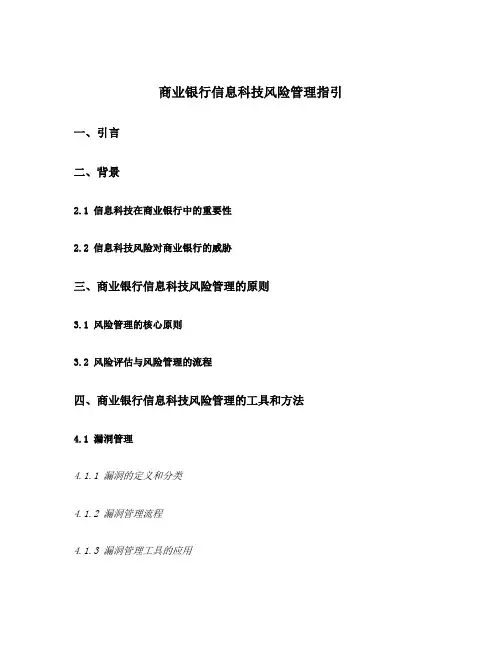
商业银行信息科技风险管理指引
一、引言
二、背景
2.1 信息科技在商业银行中的重要性
2.2 信息科技风险对商业银行的威胁
三、商业银行信息科技风险管理的原则
3.1 风险管理的核心原则
3.2 风险评估与风险管理的流程
四、商业银行信息科技风险管理的工具和方法
4.1 漏洞管理
4.1.1 漏洞的定义和分类
4.1.2 漏洞管理流程
4.1.3 漏洞管理工具的应用
4.2 安全事件的监测与响应
4.2.1 安全事件监测的重要性
4.2.2 安全事件监测与响应的流程
4.2.3 安全事件响应工具的应用
4.3 数据备份与恢复
4.3.1 数据备份的目的与要求
4.3.2 数据备份与恢复的流程
4.3.3 数据备份与恢复工具的选择
4.4 网络安全设备的选用与管理
4.4.1 常见的网络安全设备
4.4.2 网络安全设备的选用原则
4.4.3 网络安全设备的管理与维护
五、商业银行信息科技风险管理的挑战与未来发展方向
5.1 金融科技的快速发展对风险管理提出的挑战
5.2 人工智能与大数据在风险管理中的应用前景
六、总结
参考文献:
1.商业银行信息科技风险管理指引, 文号
2.XXXX年XX月XX日银行业监督管理机构发布的相关文件
3.XXXX年XX月XX日银行协会发布的相关研究报告。
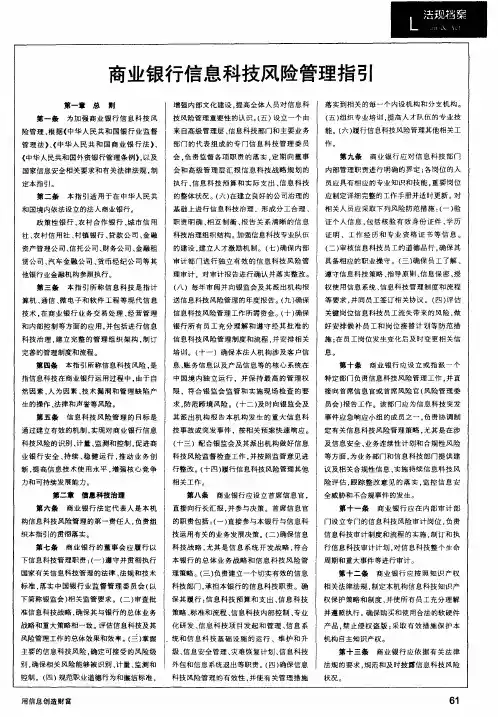
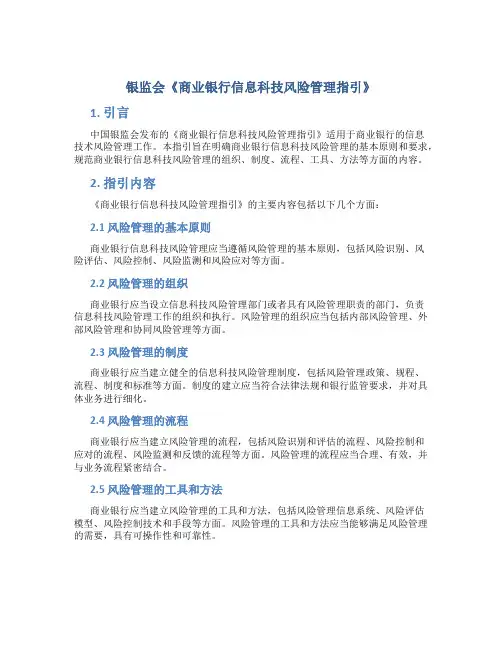
银监会《商业银行信息科技风险管理指引》1. 引言中国银监会发布的《商业银行信息科技风险管理指引》适用于商业银行的信息技术风险管理工作。
本指引旨在明确商业银行信息科技风险管理的基本原则和要求,规范商业银行信息科技风险管理的组织、制度、流程、工具、方法等方面的内容。
2. 指引内容《商业银行信息科技风险管理指引》的主要内容包括以下几个方面:2.1 风险管理的基本原则商业银行信息科技风险管理应当遵循风险管理的基本原则,包括风险识别、风险评估、风险控制、风险监测和风险应对等方面。
2.2 风险管理的组织商业银行应当设立信息科技风险管理部门或者具有风险管理职责的部门,负责信息科技风险管理工作的组织和执行。
风险管理的组织应当包括内部风险管理、外部风险管理和协同风险管理等方面。
2.3 风险管理的制度商业银行应当建立健全的信息科技风险管理制度,包括风险管理政策、规程、流程、制度和标准等方面。
制度的建立应当符合法律法规和银行监管要求,并对具体业务进行细化。
2.4 风险管理的流程商业银行应当建立风险管理的流程,包括风险识别和评估的流程、风险控制和应对的流程、风险监测和反馈的流程等方面。
风险管理的流程应当合理、有效,并与业务流程紧密结合。
2.5 风险管理的工具和方法商业银行应当建立风险管理的工具和方法,包括风险管理信息系统、风险评估模型、风险控制技术和手段等方面。
风险管理的工具和方法应当能够满足风险管理的需要,具有可操作性和可靠性。
2.6 风险管理的评估商业银行应当对风险管理工作进行评估,包括风险识别和评估、风险控制和应对、风险监测和反馈等方面。
评估应当定期进行,评估结果应当对信息科技风险管理工作产生实际作用和改进效果。
3.《商业银行信息科技风险管理指引》是银监会对商业银行信息科技风险管理工作的重要规范性文件。
商业银行应当认真研究和遵守指引中的各项要求,强化信息科技风险管理工作,提高风险管理和防范能力,在经济金融风险日趋复杂的下,确保银行业健康发展和公众资金安全。
商业银行信息科技风险管理指引—(正式版) 商业银行信息科技风险管理指引—(正式版)1:引言1.1 背景与目的1.2 适用范围1.3 术语与定义2:风险管理框架2.1 风险识别与评估2.1.1 内部审计与风险评估2.1.2 内部控制评估2.1.3 外部审计与评估2.1.4 信息系统风险评估2.2 风险治理与控制2.2.1 风险治理框架2.2.2 风险控制措施2.2.3 风险监测与报告2.3 风险应对与应急计划2.3.1 风险应对策略2.3.2 风险应急计划2.3.3 业务连续性计划3:信息系统安全3.1 信息资产保护3.1.1 安全分类与分级3.1.2 信息资产管理制度3.1.3 信息资产风险评估3.1.4 信息资产安全控制3.2 访问控制与身份认证3.2.1 访问控制策略3.2.2 身份认证机制3.2.3 会话管理3.2.4 权限管理3.3 网络与通信安全3.3.1 网络安全管理3.3.2 网络拓扑设计3.3.3 网络设备安全配置3.3.4 通信安全3.4 应用系统安全3.4.1 应用系统开发3.4.2 应用系统运维3.4.3 应用系统备份与恢复3.4.4 应用系统安全漏洞管理4:数据安全与隐私保护4.1 数据分类与处理4.2 数据安全管理4.2.1 数据备份与恢复4.2.2 数据传输与传送4.2.3 数据存储与销毁4.3 隐私保护4.3.1 隐私政策4.3.2 隐私告知与征得同意4.3.3 隐私保护措施5:技术合规与监管要求5.1 国家法律法规5.2 监管机构要求5.3 行业标准与规范5.4 自律组织要求6:附件注释:- 风险识别与评估:对银行信息科技风险进行识别和评估的过程,包括内部审计、内部控制评估、外部审计和信息系统风险评估等。
- 风险治理与控制:管理和控制银行信息科技风险的框架和措施,包括风险治理框架、风险控制措施和风险监测与报告等。
- 风险应对与应急计划:应对银行信息科技风险的策略和应急计划,包括风险应对策略和业务连续性计划等。
商业银行信息科技风险管理指引第一章总则第一条为加强商业银行信息科技风险管理,根据《中华人民共和国银行业监督管理法》、《中华人民共和国商业银行法》、《中华人民共和国外资银行管理条例》,以及国家信息安全相关要求和有关法律法规,制定本指引。
第二条本指引适用于在中华人民共和国境内依法设立的法人商业银行。
政策性银行、农村合作银行、城市信用社、农村信用社、村镇银行、贷款公司、金融资产管理公司、信托公司、财务公司、金融租赁公司、汽车金融公司、货币经纪公司等其他银行业金融机构参照执行。
第三条本指引所称信息科技是指计算机、通信、微电子和软件工程等现代信息技术,在商业银行业务交易处理、经营管理和内部控制等方面的应用,并包括进行信息科技治理,建立完整的管理组织架构,制订完善的管理制度和流程。
第四条本指引所称信息科技风险,是指信息科技在商业银行运用过程中,由于自然因素、人为因素、技术漏洞和管理缺陷产生的操作、法律和声誉等风险。
第五条信息科技风险管理的目标是通过建立有效的机制,实现对商业银行信息科技风险的识别、计量、监测和控制,促进商业银行安全、持续、稳健运行,推动业务创新,提高信息技术使用水平,增强核心竞争力和可持续发展能力。
第二章信息科技治理第六条商业银行法定代表人是本机构信息科技风险管理的第一责任人,负责组织本指引的贯彻落实。
第七条商业银行的董事会应履行以下信息科技管理职责:(一)遵守并贯彻执行国家有关信息科技管理的法律、法规和技术标准,落实中国银行业监督管理委员会(以下简称银监会)相关监管要求。
(二)审查批准信息科技战略,确保其与银行的总体业务战略和重大策略相一致。
评估信息科技及其风险管理工作的总体效果和效率。
(三)掌握主要的信息科技风险,确定可接受的风险级别,确保相关风险能够被识别、计量、监测和控制。
(四)规范职业道德行为和廉洁标准,增强内部文化建设,提高全体人员对信息科技风险管理重要性的认识。
(五)设立一个由来自高级管理层、信息科技部门和主要业务部门的代表组成的专门信息科技管理委员会,负责监督各项职责的落实,定期向董事会和高级管理层汇报信息科技战略规划的执行、信息科技预算和实际支出、信息科技的整体状况。
《商业银行信息科技风险管理指引》解读在当今数字化时代,信息科技已经成为商业银行运营和风险管理的重要组成部分。
为了规范商业银行对信息科技风险的管理,我国银监会发布了《商业银行信息科技风险管理指引》,以指导商业银行科学有效地管理信息科技风险。
本文将对该指引进行解读,并结合个人观点和理解进行探讨。
一、指引的背景和意义1.1 指引的制定背景《商业银行信息科技风险管理指引》的制定背景源于信息科技在商业银行业务中的广泛应用和风险管理问题的日益突出。
随着金融科技的发展和创新,传统风险监管和管理手段已不能满足信息科技风险管理的需要,因此需要有一套系统的指引来规范商业银行的信息科技风险管理工作。
1.2 指引的意义和作用该指引的发布,对于规范和加强商业银行信息科技风险管理具有重要意义。
指引明确了商业银行信息科技风险管理的基本原则和要求,为商业银行提供了明确的管理标准和方法。
指引强调了信息科技风险管理的全面性和系统性,从技术、业务、管理等多个方面要求商业银行全面防范和控制信息科技风险。
指引的发布将推动商业银行提升信息科技风险管理水平,从而提高整个金融体系的稳定性和安全性。
二、指引内容解读2.1 风险管理框架《商业银行信息科技风险管理指引》从整体上构建了信息科技风险管理的框架,包括风险管理原则、组织架构、风险管理流程等内容。
指引要求商业银行建立健全的信息科技风险管理框架,确保风险管理工作有序进行。
2.2 风险识别和评估指引强调了风险识别和评估的重要性,要求商业银行对信息科技风险进行全面而系统的识别和评估,包括对技术风险、业务风险、市场风险等多方面的风险进行评估,以建立全面的风险防范机制。
2.3 风险防范和控制指引对风险防范和控制提出了明确要求,包括要求商业银行建立健全的内部控制体系、加强信息系统安全管理、加强外部风险防范等方面的要求,以确保信息科技风险得到有效控制。
2.4 风险监测和报告指引要求商业银行建立健全的风险监测和报告机制,及时发现和报告信息科技风险,同时强调了监管部门对信息科技风险监测和报告的重要性,以便监管部门能够及时介入并协助商业银行解决风险。
《商业银行信息科技风险管理指引》解读《商业银行信息科技风险管理指引》是中国银监会发布的重要文件,它旨在指导商业银行在信息科技方面有效管理和控制风险。
本文将对该指引进行解读,力求全面、深入地分析其内容及意义。
指引强调了信息科技风险管理的重要性。
在当今数字化时代,商业银行的信息科技系统既是战略性工具,也是潜在的脆弱点。
对信息科技风险的管理至关重要。
指引从宏观层面提出了对信息科技风险管理的基本要求,包括确定风险管理的目标、建立风险管理体系、开展风险管理工作等方面,并具体强调了营造风险管理文化、制定风险管理制度和风险管理计划等具体措施。
指引详细介绍了信息科技风险的分类和评估方法。
在信息科技风险管理过程中,必须对不同类型的风险进行准确分类和评估,以便有针对性地采取相应的风险控制措施。
指引列举了常见的信息科技风险类型,包括网络安全风险、系统风险、数据风险等,并提出了相应的评估方法,包括风险定性和定量评估、风险定价和定量测试等。
指引还阐述了信息科技风险管控的具体措施。
在风险评估的基础上,商业银行需根据实际情况采取相应的风险管控措施。
指引中提出了不同层面的风险管控措施,包括战略层面、运营层面和技术层面,涵盖了战略规划、内控体系建设、技术监管、应急响应等方面。
指引还强调了监督评估和信息披露的重要性。
监督评估是保证风险管理工作有效开展的关键环节,指引对监督评估的内容、方法和周期进行了规定。
指引还要求商业银行要及时和全面地披露风险相关信息,以便市场和监管部门及时了解风险状况,并采取相应的措施。
《商业银行信息科技风险管理指引》的发布对于引导商业银行提高信息科技风险管理水平、提升整体风险管理能力具有重要意义。
指引为商业银行提供了系统的风险管理框架和实施细则,全面指导了商业银行在信息科技风险管理方面的工作开展。
指引的发布也激励了商业银行更加重视信息科技风险管理,并应对日益增长的信息科技风险挑战。
希望本文的解读可以进一步推广《商业银行信息科技风险管理指引》,为广大商业银行的风险管理工作提供参考和借鉴。
商业银行信息科技风险管理指引前言信息科技的发展,给商业银行带来了前所未有的便利,但其背后也隐藏着各种未知的风险。
为了有效管理信息科技风险,商业银行需要建立科学的风险管理框架,加强对信息技术的监管和控制。
一、风险管理框架风险管理框架是指商业银行根据自身特点及信息科技的风险特征,构建的风险管理结构、内控机制和管理流程。
(一)建立风险管理架构商业银行应该建立完整的风险管理架构,包括风险管理组织、风险管理制度和流程、风险管理制度执行和监督等方面。
(二)制定相关政策和管理规定商业银行要制定相关的政策、管理规定和程序,明确职责和权限,确保科学、合法、规范的风险管理。
(三)制定风险分类方法和评估方法商业银行应该根据风险的属性、来源和影响程度,制定风险分类方法和评估方法,对不同类型的风险进行精细化管理和有效控制。
(四)建立风险管理流程风险管理流程是保证商业银行信息技术风险管理工作顺利运行的重要环节,商业银行应该建立完整的风险管理流程,确保风险管理的全流程性、集成性和协同性。
二、风险管理措施商业银行信息技术风险管理的基础在于有效的措施、制度和流程。
其核心是风险管理识别、评估、治理和监控。
(一)风险识别商业银行应该建立全面、细致和科学的风险识别体系,包括人为风险、系统风险、操作风险、信息风险等方面。
(二)风险评估商业银行应该针对各个流程和环节,对风险评估进行精度化分析及合理量化,科学评估风险的大小和对银行的影响。
(三)风险治理商业银行应该根据风险评估结果,采取适当的治理措施和方法,有效控制、降低和消除风险。
(四)风险监控商业银行应该建立完善的风险监控系统,定期对风险进行全面、深入、及时监控,确保风险控制的有效性和合理性。
三、风险管理实践实际情况也是风险管理的检验场。
商业银行在实践中应该积极采取科学合理的风险管理措施,在相关领域探索符合自身特点的风险管理模式。
(一)严格的信息技术审计商业银行应该进行定期且全面的信息技术审计,检查信息系统安全策略的可行性,并及时发现和解决系统中的风险隐患。
《商业银行信息科技风险管理指引》解读《商业银行信息科技风险管理指引》是中国银行监管机构颁布的一项重要文件,旨在指导商业银行在信息科技领域管理风险,保障金融系统的稳定和安全。
通过对该指引的解读,可以更好地了解商业银行信息科技风险管理的要求和标准。
该指引强调了信息科技在商业银行业务中的重要性,指出了信息系统对银行运营、业务开展、风险管理和客户服务等方面的重要作用。
由于信息科技的飞速发展和应用,商业银行面临着越来越复杂的信息技术风险,需要加强对这些风险的管理和控制。
指引明确了信息科技风险的范畴,包括但不限于系统风险、数据和信息安全风险、网络和通讯风险、业务连续性风险等。
针对这些风险,商业银行应该建立健全的信息科技风险管理制度,包括风险管理的组织结构、责任分工、风险管理流程、内部控制和外部合作等方面。
指引规定了商业银行在信息科技风险管理方面的具体要求和标准。
要求商业银行建立健全的信息科技风险管理框架,明确信息科技风险管理的目标、政策、流程和控制措施;要求商业银行建立健全的风险评估和监测机制,确保及时识别、评估和监测信息科技风险;要求商业银行加强信息安全管理,防范数据泄露、数据篡改、网络攻击等安全风险。
指引还强调了商业银行信息科技风险管理的监督和检查。
监管部门将加强对商业银行信息科技风险管理的监督检查,对不符合规定的行为和风险管理不到位的情况给予相应的处罚和警示。
《商业银行信息科技风险管理指引》对商业银行的信息科技风险管理提出了明确的要求和标准,为商业银行规范信息科技风险管理提供了重要的指导。
商业银行应该按照该指引的要求,不断加强信息科技风险管理,确保银行的信息系统运行安全和稳定。
银监会发布《商业银行信息科技风险管理指引》为进一步加强商业银行信息科技风险管理,银监会近日发布《商业银行信息科技风险管理指引》(以下简称《管理指引》),原《银行业金融机构信息系统风险管理指引》(银监发[2006]63号,以下简称原《指引》)同时废止。
随着银行业信息化的发展,信息科技的作用已经从业务支持逐步走向与业务的融合,成为银行稳健运营和发展的支柱,原《指引》定位在信息系统风险管理的基本、原则性要求,已难以满足商业银行信息科技风险管理的需要。
为此,银监会在原《指引》的基础上,广泛征求业内机构意见,制定了本《管理指引》。
《管理指引》具有以下几个特点:一是全面涵盖商业银行的信息科技活动,进一步明确信息科技与银行业务的关系,对于认识和防范风险具有更加积极的作用;二是适用范围由银行业金融机构变为法人商业银行,其他银行业金融机构参照执行;三是信息科技治理作为首要内容提出,充实并细化了对商业银行在治理层面的具体要求;四是重点阐述了信息科技风险管理和内外部审计要求,特别是要求审计贯穿信息科技活动的整个过程之中;五是参照国际国内的标准和成功实践,对商业银行信息科技整个生命周期内的信息安全、业务连续性管理和外包等方面提出高标准、高要求,使操作性更强;六是加强了对客户信息保护的要求。
新《指引》共十一章七十六条,分为总则,信息科技治理,信息科技风险管理,信息安全,信息系统开发、测试和维护,信息科技运行,业务连续性管理,外包,内部审计,外部审计和附则等十一个部分。
新《指引》的发布,将进一步推动我国银行业信息科技风险管理向更高水平迈进。
商业银行信息科技风险管理指引第一章总则第一条为加强商业银行信息科技风险管理,根据《中华人民共和国银行业监督管理法》、《中华人民共和国商业银行法》、《中华人民共和国外资银行管理条例》,以及国家信息安全相关要求和有关法律法规,制定本指引。
第二条本指引适用于在中华人民共和国境内依法设立的法人商业银行。
政策性银行、农村合作银行、城市信用社、农村信用社、村镇银行、贷款公司、金融资产管理公司、信托公司、财务公司、金融租赁公司、汽车金融公司、货币经纪公司等其他银行业金融机构参照执行。
第三条本指引所称信息科技是指计算机、通信、微电子和软件工程等现代信息技术,在商业银行业务交易处理、经营管理和内部控制等方面的应用,并包括进行信息科技治理,建立完整的管理组织架构,制订完善的管理制度和流程。
第四条本指引所称信息科技风险,是指信息科技在商业银行运用过程中,由于自然因素、人为因素、技术漏洞和管理缺陷产生的操作、法律和声誉等风险。
第五条信息科技风险管理的目标是通过建立有效的机制,实现对商业银行信息科技风险的识别、计量、监测和控制,促进商业银行安全、持续、稳健运行,推动业务创新,提高信息技术使用水平,增强核心竞争力和可持续发展能力。
第二章信息科技治理第六条商业银行法定代表人是本机构信息科技风险管理的第一责任人,负责组织本指引的贯彻落实。
第七条商业银行的董事会应履行以下信息科技管理职责:(一)遵守并贯彻执行国家有关信息科技管理的法律、法规和技术标准,落实中国银行业监督管理委员会(以下简称银监会)相关监管要求。
(二)审查批准信息科技战略,确保其与银行的总体业务战略和重大策略相一致。
评估信息科技及其风险管理工作的总体效果和效率。
(三)掌握主要的信息科技风险,确定可接受的风险级别,确保相关风险能够被识别、计量、监测和控制。
(四)规范职业道德行为和廉洁标准,增强内部文化建设,提高全体人员对信息科技风险管理重要性的认识。
(五)设立一个由来自高级管理层、信息科技部门和主要业务部门的代表组成的专门信息科技管理委员会,负责监督各项职责的落实,定期向董事会和高级管理层汇报信息科技战略规划的执行、信息科技预算和实际支出、信息科技的整体状况。
(六)在建立良好的公司治理的基础上进行信息科技治理,形成分工合理、职责明确、相互制衡、报告关系清晰的信息科技治理组织结构。
加强信息科技专业队伍的建设,建立人才激励机制。
(七)确保内部审计部门进行独立有效的信息科技风险管理审计,对审计报告进行确认并落实整改。
(八)每年审阅并向银监会及其派出机构报送信息科技风险管理的年度报告。
(九)确保信息科技风险管理工作所需资金。
(十)确保银行所有员工充分理解和遵守经其批准的信息科技风险管理制度和流程,并安排相关培训。
(十一)确保本法人机构涉及客户信息、账务信息以及产品信息等的核心系统在中国境内独立运行,并保持最高的管理权限,符合银监会监管和实施现场检查的要求,防范跨境风险。
(十二)及时向银监会及其派出机构报告本机构发生的重大信息科技事故或突发事件,按相关预案快速响应。
(十三)配合银监会及其派出机构做好信息科技风险监督检查工作,并按照监管意见进行整改。
(十四)履行信息科技风险管理其他相关工作。
第八条商业银行应设立首席信息官,直接向行长汇报,并参与决策。
首席信息官的职责包括:(一)直接参与本银行与信息科技运用有关的业务发展决策。
(二)确保信息科技战略,尤其是信息系统开发战略,符合本银行的总体业务战略和信息科技风险管理策略。
(三)负责建立一个切实有效的信息科技部门,承担本银行的信息科技职责。
确保其履行:信息科技预算和支出、信息科技策略、标准和流程、信息科技内部控制、专业化研发、信息科技项目发起和管理、信息系统和信息科技基础设施的运行、维护和升级、信息安全管理、灾难恢复计划、信息科技外包和信息系统退出等职责。
(四)确保信息科技风险管理的有效性,并使有关管理措施落实到相关的每一个内设机构和分支机构。
(五)组织专业培训,提高人才队伍的专业技能。
(六)履行信息科技风险管理其他相关工作。
第九条商业银行应对信息科技部门内部管理职责进行明确的界定;各岗位的人员应具有相应的专业知识和技能,重要岗位应制定详细完整的工作手册并适时更新。
对相关人员应采取下列风险防范措施:(一)验证个人信息,包括核验有效身份证件、学历证明、工作经历和专业资格证书等信息。
(二)审核信息科技员工的道德品行,确保其具备相应的职业操守。
(三)确保员工了解、遵守信息科技策略、指导原则、信息保密、授权使用信息系统、信息科技管理制度和流程等要求,并同员工签订相关协议。
(四)评估关键岗位信息科技员工流失带来的风险,做好安排候补员工和岗位接替计划等防范措施;在员工岗位发生变化后及时变更相关信息。
第十条商业银行应设立或指派一个特定部门负责信息科技风险管理工作,并直接向首席信息官或首席风险官(风险管理委员会)报告工作。
该部门应为信息科技突发事件应急响应小组的成员之一,负责协调制定有关信息科技风险管理策略,尤其是在涉及信息安全、业务连续性计划和合规性风险等方面,为业务部门和信息科技部门提供建议及相关合规性信息,实施持续信息科技风险评估,跟踪整改意见的落实,监控信息安全威胁和不合规事件的发生。
第十一条商业银行应在内部审计部门设立专门的信息科技风险审计岗位,负责信息科技审计制度和流程的实施,制订和执行信息科技审计计划,对信息科技整个生命周期和重大事件等进行审计。
第十二条商业银行应按照知识产权相关法律法规,制定本机构信息科技知识产权保护策略和制度,并使所有员工充分理解并遵照执行。
确保购买和使用合法的软硬件产品,禁止侵权盗版;采取有效措施保护本机构自主知识产权。
第十三条商业银行应依据有关法律法规的要求,规范和及时披露信息科技风险状况。
第三章信息科技风险管理第十四条商业银行应制定符合银行总体业务规划的信息科技战略、信息科技运行计划和信息科技风险评估计划,确保配臵足够人力、财力资源,维持稳定、安全的信息科技环境。
第十五条商业银行应制定全面的信息科技风险管理策略,包括但不限于下述领域:(一)信息分级与保护。
(二)信息系统开发、测试和维护。
(三)信息科技运行和维护。
(四)访问控制。
(五)物理安全。
(六)人员安全。
(七)业务连续性计划与应急处臵。
第十六条商业银行应制定持续的风险识别和评估流程,确定信息科技中存在隐患的区域,评价风险对其业务的潜在影响,对风险进行排序,并确定风险防范措施及所需资源的优先级别(包括外包供应商、产品供应商和服务商)。
第十七条商业银行应依据信息科技风险管理策略和风险评估结果,实施全面的风险防范措施。
防范措施应包括:(一)制定明确的信息科技风险管理制度、技术标准和操作规程等,定期进行更新和公示。
(二)确定潜在风险区域,并对这些区域进行详细和独立的监控,实现风险最小化。
建立适当的控制框架,以便于检查和平衡风险;定义每个业务级别的控制内容,包括:1. 最高权限用户的审查。
2. 控制对数据和系统的物理和逻辑访问。
3. 访问授权以“必需知道”和“最小授权”为原则。
4. 审批和授权。
5. 验证和调节。
十八条商业银行应建立持续的信息科技风险计量和监测机制,其中应包括:(一)建立信息科技项目实施前及实施后的评价机制。
(二)建立定期检查系统性能的程序和标准。
(三)建立信息科技服务投诉和事故处理的报告机制。
(四)建立内部审计、外部审计和监管发现问题的整改处理机制。
(五)安排供应商和业务部门对服务水平协议的完成情况进行定期审查。
(六)定期评估新技术发展可能造成的影响和已使用软件面临的新威胁。
(七)定期进行运行环境下操作风险和管理控制的检查。
(八)定期进行信息科技外包项目的风险状况评价。
第十九条中资商业银行在境外设立的机构及境内的外资商业银行,应当遵守境内外监管机构关于信息科技风险管理的要求,并防范因监管差异所造成的风险。
第四章信息安全第二十条商业银行信息科技部门负责建立和实施信息分类和保护体系,商业银行应使所有员工都了解信息安全的重要性,并组织提供必要的培训,让员工充分了解其职责范围内的信息保护流程。
第二十一条商业银行信息科技部门应落实信息安全管理职能。
该职能应包括建立信息安全计划和保持长效的管理机制,提高全体员工信息安全意识,就安全问题向其他部门提供建议,并定期向信息科技管理委员会提交本银行信息安全评估报告。
信息安全管理机制应包括信息安全标准、策略、实施计划和持续维护计划。
信息安全策略应涉及以下领域:(一)安全制度管理。
(二)信息安全组织管理。
(三)资产管理。
(四)人员安全管理。
(五)物理与环境安全管理。
(六)通信与运营管理。
(七)访问控制管理。
(八)系统开发与维护管理。
(九)信息安全事故管理。
(十)业务连续性管理。
(十一)合规性管理。
第二十二条商业银行应建立有效管理用户认证和访问控制的流程。
用户对数据和系统的访问必须选择与信息访问级别相匹配的认证机制,并且确保其在信息系统内的活动只限于相关业务能合法开展所要求的最低限度。
用户调动到新的工作岗位或离开商业银行时,应在系统中及时检查、更新或注销用户身份。